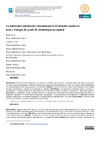Identificador persistente para citar o vincular este elemento:
https://accedacris.ulpgc.es/jspui/handle/10553/76174
| Título: | La estructura retórica de consentimientos informados usados en tesis y trabajos de grado de odontología en español | Autores/as: | Arias, Jesús Caldera, André Morales, Óscar Alberto Perdomo, Bexi Cassany, Daniel Izarra, Elix |
Clasificación UNESCO: | 570107 Lengua y literatura 550510 Filología |
Palabras clave: | Consentimiento informado Estructura retórica Tesis/Trabajo de grado Análisis de género Odontología, et al. |
Fecha de publicación: | 2020 | Publicación seriada: | LFE. Revista de Lenguas para Fines Específicos | Resumen: | Introducción: El consentimiento informado (CI) consiste en certificar que el paciente ha recibido información sobre su condición, las alternativas de tratamientos, sus efectos y consecuencias derivadas del procedimiento clínico. Su uso en la clínica odontológica ha sido ampliamente investigado, pero no en investigación. Objetivo: describir la estructura retórica del CI usado en tesis/trabajos de grado presentados en español en Latinoamérica y España. Metodología: Se analizaron la estructura retórica, secciones y movimientos y la organización de 60 documentos de CI, mediante el análisis de género y entrevistas a informantes expertos. Resultados: Se encontraron cuatros secciones sucesivas: (a) información institucional; (b) el título consentimiento informado; (c) cuerpo del documento: (1) identificación de personas involucradas, (2) descripción de la investigación, (3) afirmación de haber recibido información, (4) de haberla comprendido, (5) ratificación del consentimiento; y (d) cierre. Conclusiones: se sugiere incluir en el CI los elementos y secciones encontradas en este estudio. Introduction: Informed consent (IC) consists in certifying that the patient has received information about their condition, treatment alternatives, the effects and consequences derived from the clinical procedure. Its use in the dental clinic practice has been widely investigated, but not in research. Objective: to describe the rhetorical structure of IC used in thesis and dissertations in Spanish in Latin America and Spain. Methods: The rhetorical structure, sections and movements and the organization of 60 CI documents were analyzed, through genre analysis and interviews with expert informants. Results: Four successive sections were found: (a) institutional information; (b) the title informed consent; (c) body of document, which includes: (1) identification of persons involved, (2) description of the investigation, (3) statement of having received information, (4) having understood it, (5) ratification of consent; and (d) closure. Conclusions: it is suggested to include in the IC the elements and sections found in this study. |
URI: | https://accedacris.ulpgc.es/handle/10553/76174 | ISSN: | 2340-8561 | DOI: | 10.20420/rlfe.2020.319 | Fuente: | LFE. Revista de lenguas para fines específicos [eISSN 2340-8561], v. 26 (1), p. 149-166 |
| Colección: | Artículos |
Visitas
106
actualizado el 25-ene-2025
Descargas
77
actualizado el 25-ene-2025
Google ScholarTM
Verifica
Altmetric
Comparte
Exporta metadatos
Los elementos en ULPGC accedaCRIS están protegidos por derechos de autor con todos los derechos reservados, a menos que se indique lo contrario.
